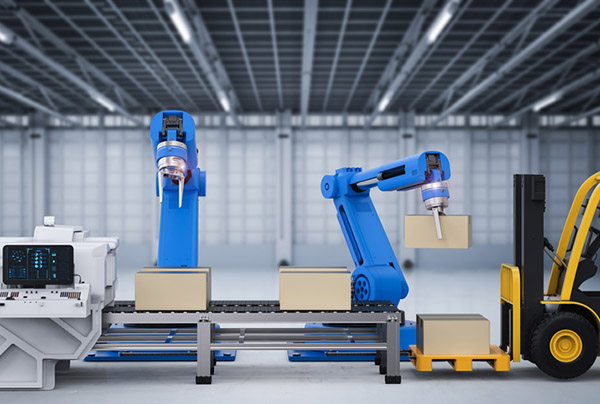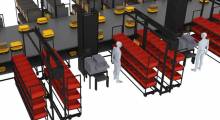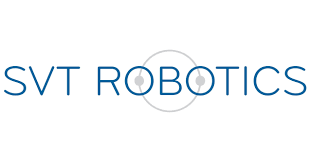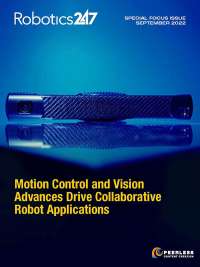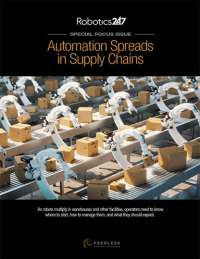The objective sounds relatively simple: On a designated day in a single distribution center, pick, pack, and ship a particular set of SKUs in a range of desired quantities to 24 retail stores. Or 50. Or 100.
That’s what a distribution center (DC) does, right? Yes and no. But there’s a problem—all those new robots.
Fulfilling orders is not all that simple if several types of robots are involved. That list could well include autonomous mobile robots (AMRs), automated lift trucks, piece-picking and goods-to-person systems, robotic putwalls, and even shuttles in an automated storage and retrieval system (ASRS).
While they can all operate in the same facility, they don’t typically interface with or talk to one another. They are islands of automation. That’s a blast from the past that wasn’t a compliment in the 1980s and 1990s, either.
Furthermore, there’s the matter of pacing and sharing the workload across those robots so store shipments can be made on schedule. Quite simply, how do they get the work done?
Good old-fashioned inventory management is both part of the challenge and central to the solution to integration of those robots.
“You want there to be enough SKUs distributed across various buffers,” said Grant Beringer, vice president of integrated systems at Swisslog. “And you don’t want to have too many items of each SKU or too few, limiting flexibility.”
None of this is a hypothetical or a one-off. Beringer and others said they have been asked more than once lately to get different types of robots to be interoperable.
As it turns out, this can be a bit of a real-world conundrum. Welcome to the new world of heterogeneous robotics integration, or HRI. (Not that we need yet another acronym, but this rolls off the tongue much more easily than that tongue twister.)
The conundrum of interoperability
HRI really is a conundrum. If you’re looking for the root of HRI solutions, start with Dwight Klappich, research vice president and Gartner fellow, and Kevin Kuntz, head of supply chain at Gap.
Klappich saw a lot of robots running around completely independent of one another, and he identified what has to happen next to make them work together.
Kuntz is the thick of it, learning how to integrate different robot types at a Gap facility in Gallatin, Tenn.
Neither is trying to be a hero. They’re just trying to solve “the biggest, hairiest problem in automation integration today,” said A.K. Schultz, founder and CEO of SVT Robotics.
Last year, Gartner ran a survey about user wants and needs for supply chain technologies. About 96% said they currently use or plan to use robots. Similarly, 93% plan to increase the size of their robotic fleets. And 94% plan to pursue other robot use cases in their facilities.
“By 2028, 50% of large enterprises will have adopted some form of intralogistics smart robots in their warehouse and manufacturing operations,” said Klappich.
Of course, no one type of robot fits all applications. In fact, Klappich said there are 34 different categories of intralogistics smart robots. They already touch operations from truck unloading and depalletizing to putaway, picking, sorting, packing, and shipping. Not to overlook replenishment and inventory management.
All of this is going to require orchestration. Klappich noted that a multi-agent orchestration platform that assigns, prioritizes, and coordinates those islands of automation is a tall order.
In his facility in Gallatin, Kuntz is living Klappich’s dream.
He already has automated storage shuttles from TGW, robotic putwalls from Kindred, robotic truck unloading from Boston Dynamics, and a storage and retrieval system Exotec dedicated to returns.
The key to innovation success is identifying quickly whether a technology can be integrated into the flow, said Kuntz. At this point, a warehouse execution system from Vargo makes that possible in Gallatin.
Or as Swisslog's Beringer pointed out, the challenge is to integrate each robot successfully so it performs well not only on its own, but as an integrated member of an automated handling system that fills orders accurately and on time.
Physical and digital connections
Fortunately, a range of suppliers is in hot pursuit of solutions. For this article, we talked with robotics, software, and complete solutions providers, and there are many others.
As you might suspect, each supplier has its own perspective on HRI, for the most part built on its current niche. And no one can go it alone. Both conditions make it clear just how new HRI is.
“The core story of heterogeneous robotic integration is all about making physical and digital connections,” explained David Schwebel, head of sales and strategic business development at RightHand Robotics.
On the physical side, each robot needs to do its job as a stand-alone piece of equipment. In addition, many of these robots need to be able to physically interface with other materials handling equipment such as conveyors or automatic guided vehicles (AGVs).
In other instances, robots need to physically interface with other robots. This is where it can start to get complex.
For instance, a piece-picking robot needs to select and remove eaches from a tote on an automated storage shuttle. But as Beringer explains, the proliferation of robots in DCs means the number of permutations of robot combinations can accumulate in relatively short order.
Then comes the tough part.
Each robot has its own software and APIs, explains Zac Boehm, vice president of innovation and technology at Hy-Tek Intralogistics. None were written to interface with other robots or additional types of automation.
But to be effective, new, digital connections have to kick in. The different robots have to communicate to move and manage the needed inventory. This digital connection is where stand-alone robots literally take on a new life with heterogeneous robotic integration.
As Boehm explains, there’s a problem to making that happen. “To communicate horizontally across equipment, you have to first communicate vertically to any of three systems—warehouse control systems [WCS], warehouse execution systems [WES], or warehouse management systems [WMS].”
Sounds simple enough. But it’s not. Klappich may have a name for it—multi-agent orchestration platforms—but they are just now being developed. As it turns out, it’s not all that easy to assign, prioritize, and coordinate tasks across islands of automation.
Orchestration platforms
The core challenge is the considerable difference between people and robots, noted SVT's Schultz. People can fill in for themselves the tasks needed to hand off an item to a tote, for instance. However, robots need to follow written code to translate each desired task into an action, says Schultz.
Writing that code is only one step, and custom developers typically connect each point-to-point solution across technologies and with enterprise software.
There’s also the matter of determining priorities for robots in each moment. That’s where the WMS, WCS, and WES come in. Each manages equipment and inventory in its own way, based on a set of priorities created to fill orders for the day. But then there needs to be a communication layer between robots and those software systems.
That’s where these multi-agent orchestration platforms come in, said Sandy Stephens, executive vice president of software and consulting at Hy-Tek. He described these platforms are a clearinghouse for data exchange among multiple autonomous agents. That’s the integration everyone wants.
“An orchestration platform does not just send messages,” according to Schutlz. “It also makes decisions and sets priorities for each piece of automated equipment. It stitches together all the ecosystems in an automated system.”
And while the platforms from Hy-Tek and SVT Robotics are different, they are both trying to agnostically enable robots of all types to interact in real time to maximize workflows.
Orchestration platforms such as these also address a common sore spot in integrating automation for materials handling. The time to write softwware for the initial integration is a common source of system launch delays.
With pre-set platforms, more of that software is already in place and ready to make full integration a reality in much less time.
If HRI sounds intimidating, that’s because it is. And while we may be at the early stages of making it manageable, there are a lot of great minds working on the problem. Your robots will not be alone.
About the Author
Follow Robotics 24/7 on Linkedin
Article topics
Email Sign Up

